With back to school it’s the perfect time to begin comminating
fall food marketing programs according to Steven Johnson Grocerant Guru® at
Tacoma, WA based Foodservice Solutions®.
In 2024 more than in past years, marketing partnerships and sponsorships have
become critical tools for driving sales, particularly in takeout, delivery, and
meal pick-up options. As the Grocerant Guru®, it's clear that these strategies
can exponentially increase a brand’s visibility and customer base, directly
translating into incremental top-line sales. Little Caesars, as the Official Pizza Sponsor of the NFL,
exemplifies how leveraging high-profile partnerships can lead to significant
growth, especially as they gear up for the 2024-2025 football season.
The Impact of Marketing Partnerships
on Takeout and Delivery Sales
Marketing partnerships, particularly with major sports
leagues like the NFL, offer restaurant chains an unparalleled platform to reach
millions of consumers. For takeout and delivery services, these partnerships
create a direct association between a popular brand and a convenient dining
option, encouraging fans to order in during games. This association is
particularly potent in the pizza segment, where game days are synonymous with
pizza nights.
Sponsorships also provide opportunities for targeted
promotions, such as limited-time offers and gamification, which can further
drive sales. For instance, Little Caesars is not only offering fee-free
delivery for the season kickoff but is also engaging fans with its Pizza!Pizza!
Pregame challenge program. These initiatives are designed to boost customer
engagement, encouraging repeat orders and fostering brand loyalty.
Five Ways Little Caesars Will Garner
Incremental Sales and New Customers
1.
Fee-Free Delivery Promotion: By
eliminating delivery fees, Little Caesars is removing a significant barrier for
customers who might otherwise hesitate to order. This move is particularly
strategic, as it taps into the convenience factor that drives takeout and
delivery orders. Free delivery not only encourages first-time orders but also
increases the frequency of repeat purchases, leading to incremental sales.
2.
NFL Star Power and Advertising
Campaigns: Partnering with NFL stars like George Kittle and Amon-Ra St. Brown
allows Little Caesars to tap into the fan bases of these athletes. Featuring
these players in commercials creates a strong emotional connection between the
brand and football fans. Additionally, Justin Jefferson’s involvement in a
primetime advertisement through the Pepsi partnership amplifies Little Caesars'
reach. These high-profile endorsements are likely to attract new customers who
are fans of these athletes and the NFL.
3.
Pizza!Pizza! Pregame Challenge Program:
The gamification of the customer experience through the Pizza!Pizza! Pregame
challenge is a brilliant way to engage customers beyond just the purchase. By
incentivizing fans to participate in challenges and earn rewards, Little
Caesars is creating a fun, interactive experience that keeps customers coming
back. This program not only drives repeat orders but also enhances customer
loyalty, resulting in sustained sales growth.
4.
Localized In-Game Activations: Little
Caesars’ partnerships with several NFL teams for localized branding and in-game
activations create a personalized experience for fans in different markets. By
aligning with local teams, Little Caesars strengthens its presence in key
markets, fostering a sense of community and loyalty among fans. This localized
approach is likely to attract new customers who feel a stronger connection to
the brand through their favorite team.
5.
Community Engagement through the Love
Kitchen: The Love Kitchen initiative, which serves pizza to communities in
need, is more than just a charitable act; it’s a powerful marketing tool. By
partnering with the NFL to roll out the Love Kitchen in key event cities,
Little Caesars is reinforcing its brand as one that cares about the community.
This positive brand image not only attracts socially conscious consumers but
also fosters goodwill that can translate into long-term customer loyalty and
incremental sales.
Think About This
Little Caesars' strategic use of food marketing
partnerships and sponsorships demonstrates the power of aligning a brand with
cultural touchpoints like NFL football. By offering value-driven promotions,
leveraging star power, and engaging in community-focused initiatives, Little
Caesars is poised to not only drive incremental top-line sales but also attract
a new generation of loyal customers. As the NFL season kicks off, Little
Caesars' playbook of fan-centered promotions and activations will undoubtedly reinforce
its position as a leader in the pizza industry, particularly in the grocerant
niche takeout and delivery segments.
Are
you looking for a new partnership to drive sales? Are you ready for some fresh
ideations? Do your food marketing tactics look more like yesterday than
tomorrow? Visit GrocerantGuru.com for more information
or contact: Steve@FoodserviceSolutions.us Remember success
does leave clues and we just may have the clue you need to propel your
continued success.


























